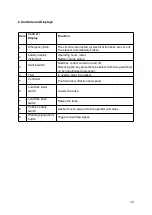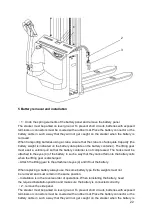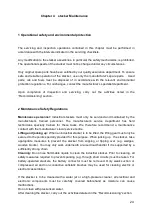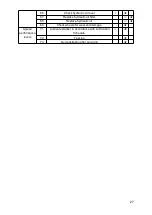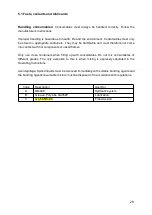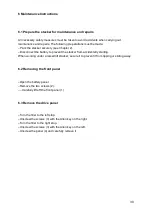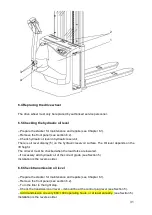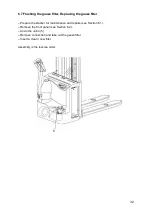
17
Braking
The braking pattern of the stacker depends largely on the track conditions. The driver
must take this into account when operating the stacker.
Braking with the Service Brake:
– Set the tiller (4) up or down to one of the brake zones (B).
The service brake is the generator brake. Only when this brake fails to achieve the necessary
brake force is the mechanical brake applied.
Plugging:
– You can set the travel switch (5) to the opposite direction when traveling.
– The stacker braked regeneratively until it starts to move in the opposite direction.
Braking with the Coasting Brake:
If the travel switch is set to 0, the stacker automatically brakes regeneratively.
Driving on inclines
Loads must always be carried on the end of the stacker facing uphill.
Preventing the stacker from “rolling downhill”:
– With the travel switch set to zero, the brake is automatically applied after a short jerk (the
controller detects the stacker is rolling back on the slope). The service brake is released again
via the travel switch, which is also used to select the speed and the travel direction.
4.3 Collecting and depositing loads
Before lifting a load, the driver must ensure that it is correctly palletised and that the
capacity of the stacker is not exceeded.
– Drive the stacker with forks as far as possible underneath the load.
With the two-stage Duplex mast (ZZ) a short, center-mounted free lift cylinder initially
lifts the load carriage (free lift) without changing the overall height of the stacker.
Lifting
–Press the “Raise Load Forks” switch (7) until the required lifting height has been reached.
Lower
– Press the “Lower Load Forks” switch (6) until the required lifting height has been reached.
Avoid fast and sudden depositing of the load.
Summary of Contents for ES10-10WA
Page 1: ...1...
Page 2: ...1...
Page 12: ...7...
Page 14: ...9 Item Description 1 Waring decal 2 Refer to manual decal 3 Truck data plate...
Page 18: ...13...










